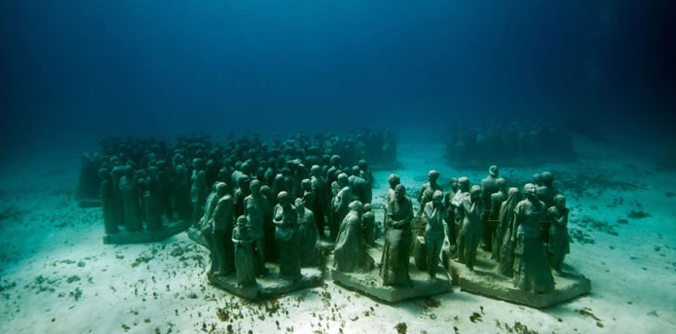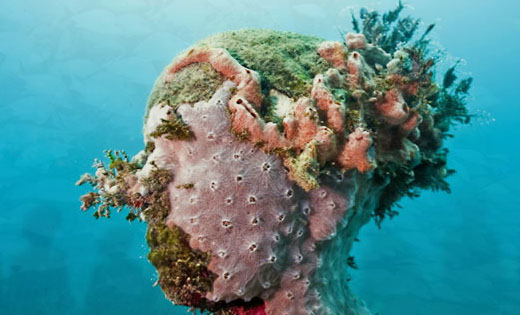
James deCaires Taylor's <a href="http://www.underwatersculpture.com/index.asp">website</a>
This is one of the coolest things I’ve seen in a long time. I don’t particularly enjoy snorkeling (too claustrophobic) but I’d try it again just to see this amazing underwater installation. Artist Jason deCaires Taylor is a former scuba instructor who’s found a novel way to reduce tourists’ footprints on Caribbean coral reefs: create a new reef. Using marine-grade cement designed to foster coral growth, deCaires Taylor sculpted more than 400 life-size human figures and submerged them 30 feet underwater. The sculpture installation—strategically located near the popular resort city of Cancún, Mexico—has already been colonized by corals and more than 1000 different types of fish plus lobsters and other creatures. As an added benefit, tourists who opt to go see deCaires Taylor’s growing reef take some of the ecological burden off of the older, more delicate reefs nearby.

Wildlife get a bonus too: new reefs mean that fish have a new home, and smaller animals can dart down to the sculpture’s feet when they see a predator swimming above. Eventually, according to National Geographic, the sculptures would cover around 4,250 square feet, making it one of the largest underwater art installations in the world.
DeCaires Taylor’s project definitely has an ecological impact, and an aesthetic one as well. The figures look extremely eerie in the fluctuating light, despite being only 30 feet below the sunny surface of the ocean. The faces growing algae evoke victims of shipwrecks, and like human bodies, their decomposition feeds other creatures. There’s something intriguing about the continually changing and developing nature of this art: it’s definitely “alive” in the most literal sense, but it’s also an artificial, human-made structure that’s been plunked down in the ocean. It may not be for every art-lover, but the fish sure seem to love it. More cool images from the exhibition in the video below.
Jason DeCaires Taylor Underwater Sculpture from Christian Sandino-Taylor on Vimeo.







